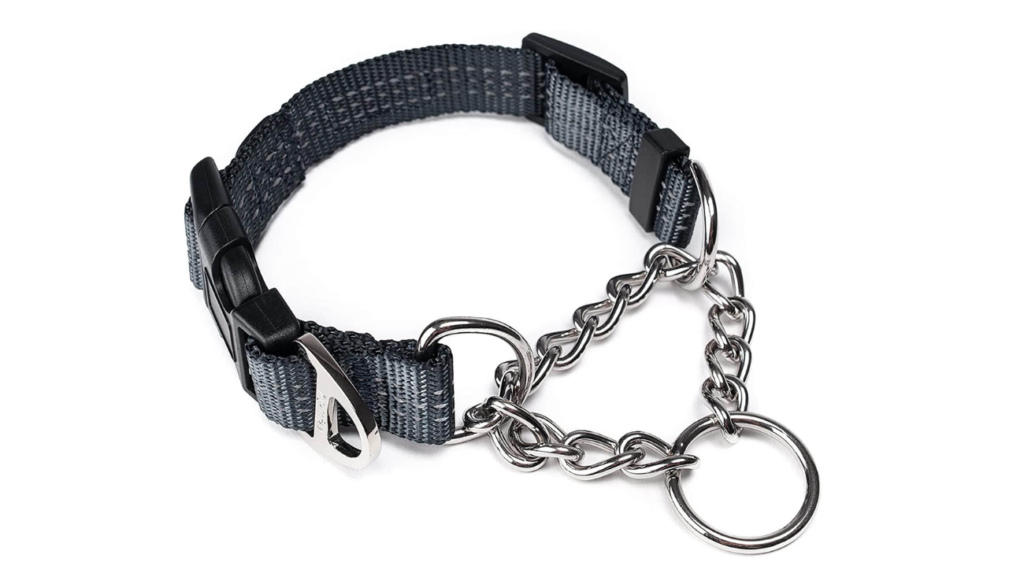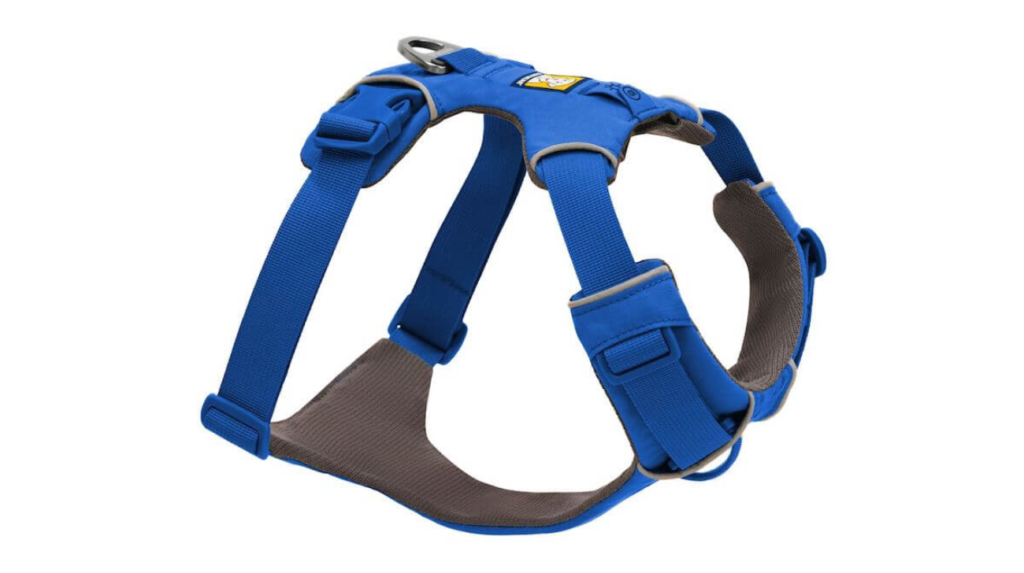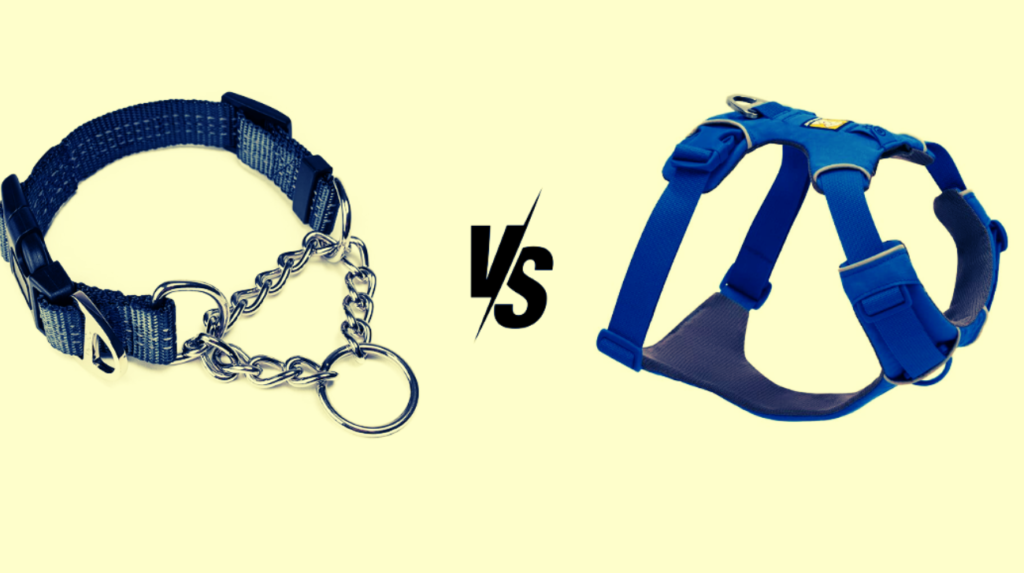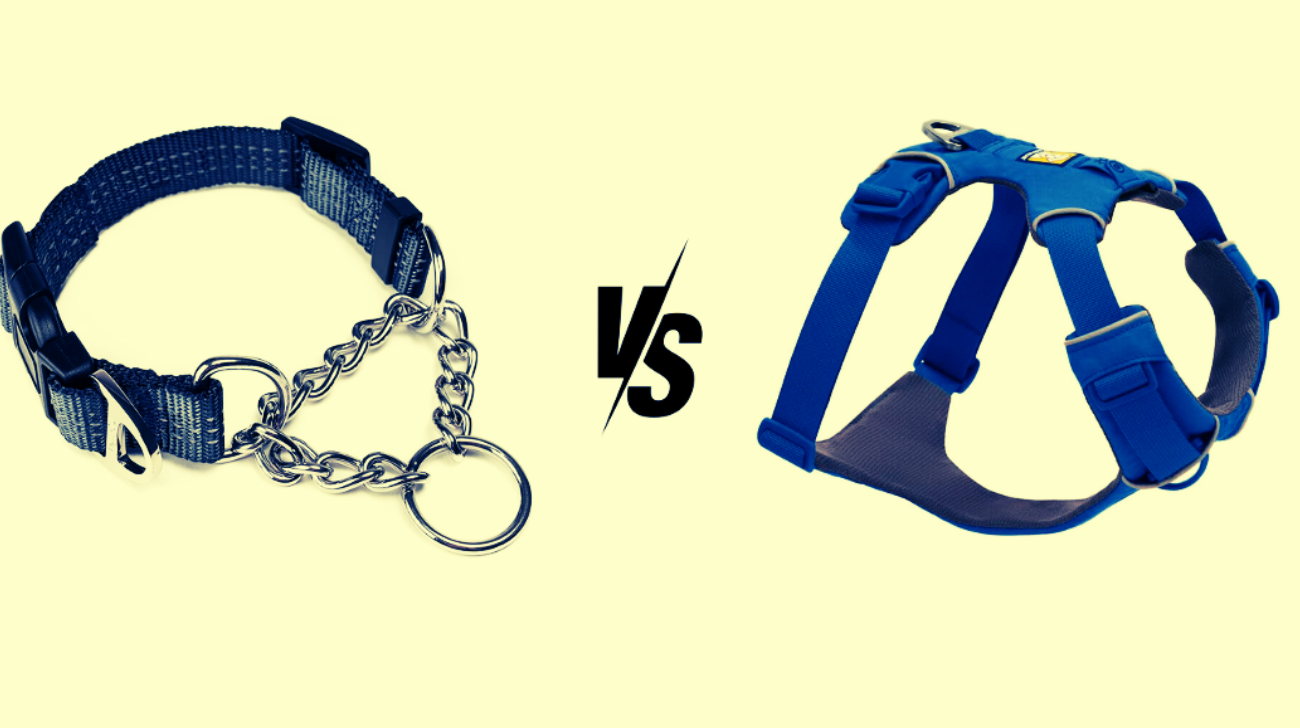Dog training is as much about understanding your dog’s personality and needs as it is about choosing the right tools. For many dog owners, the choice between a martingale collar vs harness can be a tough one, especially when it comes to managing pulling, controlling escape-prone breeds, or ensuring everyday comfort. Both tools have unique benefits and are suited for different dogs and scenarios.
I’ll break down the features, advantages, and potential drawbacks of martingale collars and harnesses. Whether you’re raising a new puppy or refining an older dog’s behavior, understanding the differences will help you make an informed decision. Discover why Afghan Hound collars are wide by exploring the unique characteristics of this breed and how wide collars enhance their comfort and style.
Blog Highlights
ToggleMy Personal Opinion
Over the years, I’ve found that martingale collars work wonders for dogs with narrow heads, like Greyhounds or Whippets, who can easily slip out of traditional collars. They provide a comfortable yet secure option for training and everyday walks.
Harnesses, on the other hand, are my go-to for dogs that pull excessively or have respiratory issues. They offer better control over pulling behaviors while reducing strain on the dog’s neck, making them a safe and versatile option for most breeds. Find out what style dog collar is best for hounds to ensure comfort and safety for your furry friend.
What Is a Martingale Collar?
A martingale collar is a specialized collar designed with a loop system that tightens gently when the dog pulls but doesn’t choke or constrict. Its primary purpose is to prevent escape while ensuring comfort and control.

Key Features of the Martingale Collar:
- Two-Loop Design: One loop fits around the dog’s neck, while the second loop tightens when the dog pulls.
- Gentle Pressure: The tightening action provides just enough pressure to discourage pulling without causing harm.
- Non-Slip Mechanism: Perfect for breeds with narrow heads that tend to slip out of traditional collars.
Benefits of the Martingale Collar:
- Escape Prevention: Ideal for sighthounds and other dogs prone to slipping out of collars.
- Gentle Corrections: Encourages better leash manners without causing pain.
- Comfortable for Daily Use: Soft materials like nylon or fabric reduce the risk of skin irritation.
- Ease of Use: No special skills are required to fit or adjust.
Limitations of the Martingale Collar:
- Less Control for Strong Pullers: While great for mild pullers, it may not be sufficient for large or stubborn dogs.
- Not Suitable for Aggressive Dogs: It doesn’t provide the level of correction needed for severe behavior issues.
- Limited Versatility: Designed primarily for walking and light training.
The ideal size collar for English Springer Spaniel typically ranges from 14 to 20 inches, depending on the dog’s age and neck size, ensuring a comfortable and secure fit.
What Is a Harness?
A harness is a device worn around a dog’s chest and shoulders, distributing pressure across the body rather than focusing on the neck. Harnesses come in various designs, including front-clip, back-clip, and dual-clip options, each suited for different training and walking needs.

Key Features of a Harness:
- Pressure Distribution: Evenly spreads force across the chest and shoulders, reducing strain on the neck.
- Multiple Attachment Points: Front-clip for training, back-clip for casual walks, and dual-clip for versatile use.
- Adjustable Fit: Straps allow for customization to ensure comfort and security.
Benefits of a Harness:
- Reduces Neck Strain: Ideal for dogs with respiratory issues or sensitive necks.
- Better Control Over Pulling: Front-clip harnesses are particularly effective for training strong pullers.
- Prevents Injuries: Safer for dogs with tracheal or spinal problems.
- Escape-Proof Options: Some harnesses are designed to prevent even the most determined escape artists.
Limitations of a Harness:
- Bulkier Than Collars: Can feel restrictive or uncomfortable if not fitted properly.
- Training Needed: Some dogs may resist wearing a harness initially.
- Not Ideal for All-Day Wear: Prolonged use can cause chafing or irritation if the harness isn’t well-padded.
The recommended size collar for an English Cocker Spaniel usually ranges from 12 to 18 inches, providing a snug and comfortable fit for your dog.
Comparing Martingale Collar vs Harness: Key Differences
Both the martingale collar vs harness have distinct advantages based on a dog’s needs and the owner’s goals. Let’s compare their features side-by-side:
Detailed Differences Between Martingale Collar vs Harness
Let’s dive deeper into how martingale collars and harnesses compare in terms of design, safety, training effectiveness, and suitability.

1. Design and Structure
Martingale Collar:
The martingale collar’s two-loop design ensures a snug fit that tightens gently when the dog pulls. It’s particularly effective for breeds with narrow heads, like Greyhounds, ensuring the collar stays securely in place.
Harness:
Harnesses come in various designs, with options to suit different training and walking needs. For example, a front-clip harness is excellent for training dogs to stop pulling, while a back-clip harness offers comfort for everyday use.
Key Difference:
Martingale collars focus on preventing escape and gentle corrections, while harnesses provide more comprehensive control and pressure distribution.
To find the perfect fit, learn more about what size collar for a Bichon, ensuring your dog’s comfort and safety.
2. Control and Effectiveness
Martingale Collar:
Martingale collars offer moderate control, making them ideal for dogs with mild pulling tendencies. However, they are not as effective for large, strong dogs that require firmer corrections.
Harness:
Harnesses excel in controlling pulling behaviors, especially when using a front-clip design. They give the handler more leverage and minimize the risk of injury to the dog’s neck.
Key Difference:
Harnesses provide better control for strong pullers, while martingale collars are best for mild pullers or escape-prone dogs.
3. Comfort and Safety
Martingale Collar:
When fitted correctly, a martingale collar is comfortable for most dogs and doesn’t cause choking. However, it’s not suitable for dogs with respiratory or neck issues.
Harness:
Harnesses are safer for dogs with health concerns, as they distribute pressure away from the neck. Padded harnesses further enhance comfort, reducing the risk of chafing.
Key Difference:
Harnesses are generally safer and more comfortable for dogs with medical issues, while martingale collars are better suited for specific training needs.
Discover the ideal option by exploring what is the best collar material for a Bichon Frise to ensure your pet’s comfort and durability.
4. Training Effectiveness
Martingale Collar:
The gentle tightening action of a martingale collar is effective for leash training and discouraging pulling. It’s also a great tool for teaching dogs not to slip out of their collars.
Harness:
Harnesses are particularly effective for training dogs to stop pulling, especially when using a front-clip design. They offer better control over strong, energetic dogs.
Key Difference:
Harnesses are more versatile for training purposes, while martingale collars are ideal for specific training goals like preventing escape.
5. Suitability for Different Dogs
Martingale Collar:
Best for escape-prone breeds, like Greyhounds or Whippets, and dogs with mild pulling tendencies.
Harness:
Suitable for a wide range of dogs, including strong pullers, dogs with medical issues, and puppies learning to walk on a leash.
Key Difference:
Harnesses are more versatile and cater to a broader range of dogs, while martingale collars are designed for specific needs.
The American Staffordshire Terrier’s coat type is short, sleek, and easy to maintain with regular brushing.
Using the Tools Safely: Essential Tips

How to Fit a Martingale Collar:
- Adjust the collar to fit snugly but not too tight.
- Ensure the collar can tighten slightly without choking the dog.
- Position the collar high on the neck, near the ears, for better control.
How to Fit a Harness:
- Choose the right size based on your dog’s measurements.
- Adjust the straps to ensure a snug yet comfortable fit.
- Regularly check for signs of chafing or irritation.
Safety Considerations:
- Always supervise your dog when using a martingale collar or harness.
- Pair these tools with positive reinforcement techniques for the best results.
- Consult a professional trainer if you’re unsure how to use either tool effectively.
Wrapping Up
Choosing between a martingale collar vs harness depends on your dog’s specific needs, behavior, and your training goals. Martingale collars are excellent for preventing escapes and managing mild pullers, making them ideal for sighthounds and dogs with narrow heads.
Harnesses, on the other hand, offer superior control, safety, and versatility, especially for dogs that pull or have medical concerns. They are a popular choice for training, everyday walks, and ensuring your dog’s comfort and well-being. The best collar size for an American Staffordshire Terrier ensures a comfortable and secure fit for your dog during walks and training.
By considering your dog’s breed, temperament, and unique requirements, you can select the tool that best complements your training and lifestyle. Remember, every dog is different, and finding the right fit may involve a bit of trial and error. But with patience and consistency, both martingale collars and harnesses can help you and your furry friend enjoy safe and happy walks.







